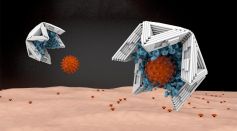Tags: Nanotechnology
'Nanocolloidal' Hydrogel Ink Potential for Anti-Counterfeiting Protection; Study Describes Results as Safe, Eco-friendly and Useful for Food Industry
Nanoscale Manipulation of Electrons and Other Molecules Possible for the First Time Through Geometric Confinement
LEDs Developed Using Perovskite Nanocrystals Found to Be More Eco-Friendly and Low-Cost
Plant and Bacteria Nanoparticles Used to Develop Fridge-Free COVID-19 Vaccine; Here's How It Works
Strange Electron Behavior Found in IBSC, Could Help Explain Superconductivity
Carbon Nanotube Fibers Woven Into a Regular Shirt to Accurately Monitor Heart Rate; Can It Replace Smartwatches, Chest Straps?

Crystal to Control Spin Qubits by the Millions; Could Solve Current Quantum Computing Design Limits
Research Brings New Technique That Locates, Monitors Individual Atoms in Nanoparticles While Moving
New Bioresponsive MTN System Clears an Invasive Fungi In Vivo; Advances Fight Against Fungal Infections
Silver Nanowires Can Be Potential Alternatives for Everyday Devices Like Mobile Phones, Solar Panels; Boasts Better Quality, Versatility
Colorectal Cancer, Melanoma May Potentially Be Treated Through the Use of This Novel Nanotechnology

DNA-Constructed Nanomaterials Possible to Trap and Neutralize Virus

Novel Nanotechnology Can Generate Electricity Using Internal Organs of the Human Body, Replacing Batteries
Graphene-Based Nano-Inks: Researchers Investigate How an Energy Device Can Charge, Discharge Ultrafast
World's Tiniest Technology Thin Film That Is TWO Atoms Thick Used to Store Electric Information

Engineered Nanobodies Offer Hope in the Long Run Against COVID-19 and its Variants
Hexagonal Boron Nitride Dubbed the Toughest 2D Materials, Here's Why
Nanocapsules on Blood Clot Drugs Reduce Side Effects, Increase Efficacy
Nanoelectronics, Semiconductors Benefit from Newly-Developed Electromigration Solution

Friction-Powered Clothing Can Give Self-Sufficient Energy for Wearables
Most Popular

Will Earth's Magnetic Poles Flip Next? Magnetic Pole Reversal Explained Through Cutting‑Edge Magnetosphere Science

Relativity Time Dilation Explained: The Physics of Time and Why It Moves Differently in Space

How Lightning Science Reveals Why Charged Storms Are Rising with Global Warming Effects

De-Extinction vs. Conservation Science: Which Approach Protects Biodiversity Most Effectively?




